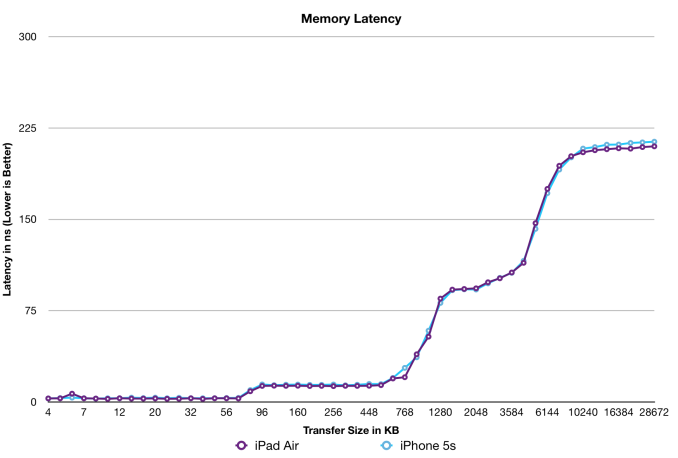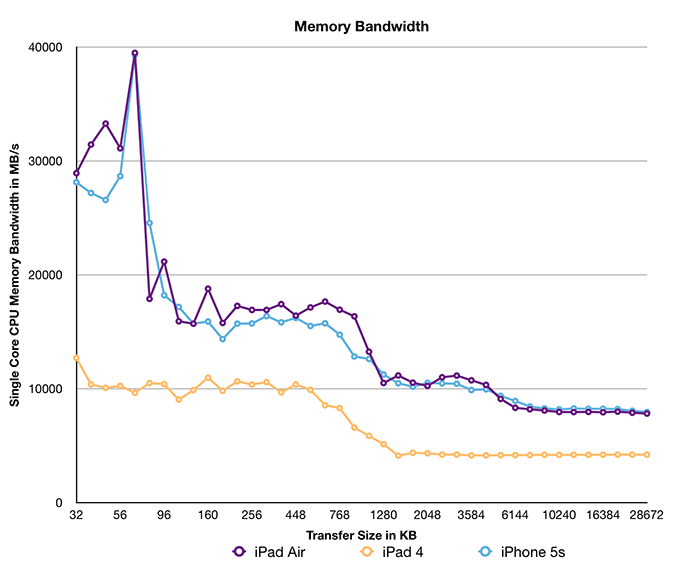The iPad Air Review
by Anand Lal Shimpi on October 29, 2013 9:00 PM ESTAn Update on Apple’s A7: It's Better Than I Thought
When I reviewed the iPhone 5s I didn’t have much time to go in and do the sort of in-depth investigation into Cyclone (Apple’s 64-bit custom ARMv8 core) as I did with Swift (Apple’s custom ARMv7 core from A6) the year before. I had heard rumors that Cyclone was substantially wider than its predecessor but I didn’t really have any proof other than hearsay so I left it out of the article. Instead I surmised in the 5s review that the A7 was likely an evolved Swift core rather than a brand new design, after all - what sense would it make to design a new CPU core and then do it all over again for the next one? It turns out I was quite wrong.
Armed with a bit of custom code and a bunch of low level tests I think I have a far better idea of what Apple’s A7 and Cyclone cores look like now than I did a month ago. I’m still toying with the idea of doing a much deeper investigation into A7, but I wanted to share some of my findings here.
The first task is to understand the width of the machine. With Swift I got lucky in that Apple had left a bunch of public LLVM documentation uncensored, referring to Swift’s 3-wide design. It turns out that although the design might be capable of decoding, issuing and retiring up to three instructions per clock, in most cases it behaved like a 2-wide machine. Mix FP and integer code and you’re looking at a machine that’s more like 1.5 instructions wide. Obviously Swift did very well in the market and its competitors at the time, including Qualcomm’s Krait 300, were similarly capable.
With Cyclone Apple is in a completely different league. As far as I can tell, peak issue width of Cyclone is 6 instructions. That’s at least 2x the width of Swift and Krait, and at best more than 3x the width depending on instruction mix. Limitations on co-issuing FP and integer math have also been lifted as you can run up to four integer adds and two FP adds in parallel. You can also perform up to two loads or stores per clock.
I don’t yet have a good understanding of the number of execution ports and how they’re mapped, but Cyclone appears to be the widest ARM architecture we’ve ever seen at this point. I’m talking wider than Qualcomm’s Krait 400 and even ARM’s Cortex A15.
I did have some low level analysis in the 5s review, where I pointed out the significantly reduced memory latency and increased bandwidth to the A7. It turns out that I was missing a big part of the story back then as well…
A Large System Wide Cache
In our iPhone 5s review I pointed out that the A7 now featured more computational GPU power than the 4th generation iPad. For a device running at 1/8 the resolution of the iPad, the A7’s GPU either meant that Apple had an application that needed tons of GPU performance or it planned on using the A7 in other, higher resolution devices. I speculated it would be the latter, and it turns out that’s indeed the case. For the first time since the iPad 2, Apple once again shares common silicon between the iPhone 5s, iPad Air and iPad mini with Retina Display.
As Brian found out in his investigation after the iPad event last week all three devices use the exact same silicon with the exact same internal model number: S5L8960X. There are no extra cores, no change in GPU configuration and the biggest one: no increase in memory bandwidth.
Previously both the A5X and A6X featured a 128-bit wide memory interface, with half of it seemingly reserved for GPU use exclusively. The non-X parts by comparison only had a 64-bit wide memory interface. The assumption was that a move to such a high resolution display demanded a substantial increase in memory bandwidth. With the A7, Apple takes a step back in memory interface width - so is it enough to hamper the performance of the iPad Air with its 2048 x 1536 display?
The numbers alone tell us the answer is no. In all available graphics benchmarks the iPad Air delivers better performance at its native resolution than the outgoing 4th generation iPad (as you'll soon see). Now many of these benchmarks are bound more by GPU compute rather than memory bandwidth, a side effect of the relative lack of memory bandwidth on modern day mobile platforms. Across the board though I couldn’t find a situation where anything was smoother on the iPad 4 than the iPad Air.
There’s another part of this story. Something I missed in my original A7 analysis. When Chipworks posted a shot of the A7 die many of you correctly identified what appeared to be a 4MB SRAM on the die itself. It's highlighted on the right in the floorplan diagram below:

A7 Floorplan, Courtesy Chipworks
While I originally assumed that this SRAM might be reserved for use by the ISP, it turns out that it can do a lot more than that. If we look at memory latency (from the perspective of a single CPU core) vs. transfer size on A7 we notice a very interesting phenomenon between 1MB and 4MB:
That SRAM is indeed some sort of a cache before you get to main memory. It’s not the fastest thing in the world, but it’s appreciably quicker than going all the way out to main memory. Available bandwidth is also pretty good:
We’re only looking at bandwidth seen by a single CPU core, but even then we’re talking about 10GB/s. Lookups in this third level cache don’t happen in parallel with main memory requests, so the impact on worst case memory latency is additive unfortunately (a tradeoff of speed vs. power).
I don’t yet have the tools needed to measure the impact of this on-die memory on GPU accesses, but in the worst case scenario it’ll help free up more of the memory interface for use by the GPU. It’s more likely that some graphics requests are cached here as well, with intelligent allocation of bandwidth depending on what type of application you’re running.
That’s the other aspect of what makes A7 so very interesting. This is the first Apple SoC that’s able to deliver good amounts of memory bandwidth to all consumers. A single CPU core can use up 8GB/s of bandwidth. I’m still vetting other SoCs, but so far I haven’t come across anyone in the ARM camp that can compete with what Apple has built here. Only Intel is competitive.












444 Comments
View All Comments
Fx1 - Wednesday, October 30, 2013 - link
The only issue i have with this review is that you took 10 whole pages to basically review the same ipad that has been around for years which is just slightly faster and slimmer than last years. Its a locked down boring tablet for kiddy users.Streamlined - Wednesday, October 30, 2013 - link
That's funny because I'm a financial analyst and the most popular tablet among professionals who use their tablet for WORK in Fortune 500 level companies is the ipad.darkcrayon - Thursday, October 31, 2013 - link
Right, the tablet with the most compelling apps and arguably the most powerful hardware is surely boring and for kiddy users. By your laughable standard, pretty much any computer in any category is the same as the last several.gattacaDNA - Wednesday, October 30, 2013 - link
As far as I know, Apple has not begun printing US currency. So everyone is entitled to spend their $ on whatever tablet or other device strokes their fancy / fantasies. All this lambasting and "mine's bigger than yours" is a childish waste of time. Nearly every review in every medium has some sort of bias. Hell you demonstrate bias every day when you choose who to eat a meal with - get over it. Buy what devices you want and the market and stock prices will decide what futures are delivered - all are viable until proven otherwise. Peace.gnx - Wednesday, October 30, 2013 - link
1 lbs is the threshold for easy to hold in hand. I felt so after using a iPad and a Galaxy Tab 10.1 and then Galaxy Tab 8.9 and iPad2.In terms of form factor, personally, I though Samsung already had the best product in 2011 with the Galaxy Tab 8.9: screen real estate comparable to an iPad/iPad2 (the same height in portrait, just a bit more compact in width) but lighter and thinner (under 1 lbs). So I was dismayed to see Samsung not follow up with a successor to the Galaxy Tab 8.9, while Apple went for heavier and thicker with iPad3 & iPad4. Smaller tablets like the Galaxy Tab 7.7, Nexus 7 and iPad Mini (7.9)/Galaxy Note 8.0 all sacrificed screen space too much, for someone like me who reads a lot of documents on them.
Personally, cause I'm frustrated with the lack of widgets on iOS, I am partial to Android. But if Google or Samsung or Asus don't come up with a 8.9 or 10.1 under 1lbs, the iPad Air may be my only choice for an upgrade .....
Death666Angel - Wednesday, October 30, 2013 - link
Amazon HDX 8.9" not for you? :) The software does have issues, but it checks all the right boxes. Might work for you. Either the last one for price and good-enough performance of this years with higher prices (still lower than iPad) and higher performance, better specs to go with it.gnx - Thursday, October 31, 2013 - link
I also love the form factor of the Kindle HDX 8.9 - superb dimensions and weight in my opinion. But I have to sadly admit I am also tied to several google apps, namely, gmail, google voice, google calendar and a few others, and though both iOS and Android provide support, forked Amazon Fire OS doesn't ... this is more Google's call than Amazon's fault, but admittedly, it limits my choice to an iPad or Nexus/Samsung/Asus etc ...solipsism - Thursday, October 31, 2013 - link
Comparable? The Galaxy 8.9 is closer to the display are of the iPad MINI than to the iPad (Air).Death666Angel - Thursday, October 31, 2013 - link
If my math isn't wrong and the screen size calculator I used is correct (on draperin.com), then the HDX 8.9" has 231cm² display surface, the iPad Mini 172cm² and the iPad Air 243cm², which seems to invalidate your statement.thunng8 - Thursday, October 31, 2013 - link
Your math is wrong. Not sure if you accounted for different aspects ratiosBy my calculations (LxW=Area (cm^2):
iPad mini=16x12=192
Fire HDX=19.15x12=230
iPad Air=19.7x14.8=292